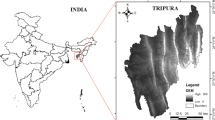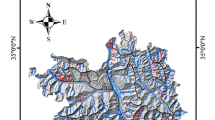Abstract
As landslides are very common in Greece, causing serious problems to the social and economic welfare of many communities, the implementation of a proper hazard analysis system will help the creation of a reliable susceptibility map. Τhis will help local communities to define a safe land use and urban development. The purpose of this study is to compare the implementation of two semi-quantitative landslide assessment approaches, using landslide susceptibility maps compiled in a GIS environment. The compared methods are rock engineering system (RES) and the analytic hierarchy process (AHP). For the landslide susceptibility analysis, the Northeastern part of the Achaia County was examined. This area suffers from many landslides, because of its neighborhood with the tectonically active Corinthian Gulf and its geological setting (Neogene sediments, flysch and other bedrock formations, with local overthrusts). Ten parameters were used in both methodologies, and each one was separated into five categories ranging from 0 to 4, representing their specific conditions derived from the investigation of the landslides in the western part of the study area (ranking area). A layer map was generated for each parameter, using GIS, while the weighting coefficients of each methodology were used for the compilation of RES and AHP final maps of the eastern part of the study area (validating area). By examining these two maps, it is revealed that even though both correctly show the landslide status of the second site, the RES map reveals a better behavior in the spatial distribution of the various landslide susceptibility zones.







Similar content being viewed by others
References
Akgün A, Bulut F (2007) GIS-based landslide susceptibility for Arsin-Yomra (Trabzon, North Turkey) region. Environ Geol 51:1348–1377. doi:10.1007/s00254-006-0435-6
Akgün A, Dag S, Bulut F (2008) Landslide susceptibility mapping for landslide-prone area (Findikli, NE Turkey) by likelihood-frequency ratio and weighted linear combination models. Environ Geol 54:1127–1143. doi:10.1007/s00254-007-0882-8
Ayalew L, Yamagishi H (2005) The application of GIS-based logistic regression for landslide susceptibility mapping in the Kakuda-Yahiko Mountains, Central Japan. Geomorphology 65:15–31
Ayalew L, Yamagishi H, Ugawa N (2004) Landslide susceptibility mapping using GIS-based weighted linear combination, the case in Tsugawa area of Agano River, Niigata Prefecture, Japan. Landslides 1:73–81. doi:10.1007/s10346-003-0006-9
Ayalew L, Yamagishi H, Marui H, Kanno T (2005) Landslides in Sado Island of Japan: Part II. GIS-based susceptibility mapping with comparisons of results from two methods and verifications. Eng Geol 81:432–445
Bathrellos GD, Kalivas DP, Skilodimou HD (2009) GIS-based landslide susceptibility mapping models applied to natural and urban planning in Trikala, Central Greece. Estud Geol 65:49–65. doi:10.3989/egeol.08642.036
Bossard M, Feranec J, Otahel J (2000) CORINE land cover technical guide—Addendum 2000. European Environment Agency, Copenhagen, p 104
Carrara A, Cardinali M, Detti R, Guzzetti F, Pasqui V, Reichenbach P (1991) GIS techniques and statistical models in evaluating landslide hazard. Earth Surf Proc Land 16:427–445
Casale R, Margottini C (1999) Floods and landslides. Springer, Berlin
Castellanos Abella EA, Van Westen CJ (2007) Generation of landslide risk index map for Cuba using spatial multi-criteria evaluation. Landslides 4:311–325. doi:10.1007/s10346-007-0087-y
Chau KT, Sze YL, Fung MK, Wong WY, Fong EL, Chan LCP (2004) Landslide hazard analysis for Hong Kong using landslide inventory and GIS. Comput Geosci 30:429–443
Donati L, Turrini MC (2002) An objective method to rank the importance of the factors predisposing to landslides with the GIS methodology: application to an area of the Apennines (Valnerina; Perugia, Italy). Eng Geol 63:277–289
Doutsos T, Kontopoulos N, Frydas D (1987) Neotectonic evolution of northwestern—continental Greece. Geol Rundsch 76:433–450
Doutsos T, Kontopoulos N, Poulimenos E (1988) The Corinth–Patras rift as the initial stage of continental fragmentation behind an active island arc (Greece). Basin Res 1/3:177–190. doi:10.1111/g.1365-2117.1988.tb00014.x
Gaki-Papanastassiou K, Papanastassiou D, Maroukian H (1996) Geomorphic and archaeological—historical evidence for past earthquakes in Greece. Ann Geofis 39:589–601
Glade T (1998) Establishing the magnitude and frequency of landslide triggering rainstorm events in New Zealand. Environ Geol 35:2–3
Guthrie RH, Evans SG (2004) Analysis of landslide frequencies and characteristics in a natural system, coastal British Columbia. Earth Surf Proc Land 29:1321–1339
Guzzetti F, Carrara A, Cardinali M, Reichenbach P (1999) Landslide hazard evaluation: a review of current techniques and their application in a multi-scale study, Central Italy. Geomorphology 31:181–216
Helias DI (1978) Some meteorological and climatological data of Rio-Antirio bridge site. In: Proceedings of international congress for Rio-Antirio bridge site. Editor University of Patras, Patra, pp 17–34
Hudson JA (1992) Rock engineering systems. Theory and practice, Ellis Horwood series in Civil Engineering, pp 185
IGME (1993) Geological map of Greece, at a scale of 1:50,000, Dervenion sheet, Athens
IGME (2005) Geological map of Greece, at a scale of 1:50,000, Aigion sheet, Athens
Irigaray C (1995) Movimientos de ladera: inventoria, analisis y cartografaa de susceptibilidad mediante un Sistema de Informacion Geografica. Aplicacion a las zonas de Colmenar (Ma), Rute (Co) y Montefrio (Gr). Thesis Doctoral, University Granada
Irigaray C, Fernandez T, El Hamdouni R, Chacon J (1999) Verification of landslide susceptibility mapping. A case study. Earth Surf Proc Land 24:537–544
Irigaray C, Fernandez T, El Hamdouni R, Chacon J (2007) Evaluation and validation of landslide-susceptibility obtained by GIS matrix method: examples from the Betic Cordillera (southern Spain). Nat Hazards 41:61–79
Jurko J, Paudits P, Vlcko J (2005) Landslide susceptibility zonation using GIS-statistical approach. In: International symposium on latest natural disasters—new challenges for engineering geology, IAEG, 1–7, September, Sofia
Kanungo DP, Arora MK, Sarkar S, Gupta RP (2006) A comparative study of conventional, ANN black box, fuzzy and combined neural and fuzzy weighting procedures for landslide susceptibility zonation in Darjeeling Himalayas. Eng Geol 85:347–366
Komac M (2006) A landslide susceptibility model using the analytical hierarchy process method and multivariate statistics in perialpine Slovenia. Geomorphology 74:17–28
Koukis G (1988) Slope deformation phenomena related to the engineering geological conditions in Greece. In: Proceedings of the 5th int symposium on landslides, vol 2, pp 1187–1192, Laussanne. Balkema, Rotterdam
Koukis G, Rozos D (1982) Geotechnical conditions and landslide phenomena in Greek territory, in relation with geological structure and geotectonic evolution. Mineral Wealth 16:53–69 (in Greek, with summary in English)
Koukis G, Sabatakakis N (2000) Engineering geological environment of Athens, Greece. Bull Eng Geol Environ 59:127–135
Koukis G, Rozos D, Hatzinakos I (1997) Relationship between rainfall and landslides in the formations of Achaia County, Greece. In: Proc of international symposium of IAEG in engineering geology and the environment, Balkema, Rotterdam, vol 1, pp 793–798
Lan HX, Zhou CH, Wang LJ, Zhang HY, Li RH (2004) Landslide hazard spatial analysis and prediction using GIS in the Xiaojiang watershed, Yunnan, China. Eng Geol 76:109–128
Larsen MC, Parks JE (1997) How wide is a road? The association of roads and mass movements in a forested montane environment. Earth Surf Proc Land 22:835–848
Lee S, Pradhan B (2007) Landslide hazard mapping at Selangor, Malaysia using frequency ratio and logistic regression models. Landslides 4:33–41. doi:10.1007/s10346-006-0047-y
Lee S, Sambath T (2006) Landslide susceptibility mapping in the Dammrei Romel area, Cambodia using frequency ratio and logistic regression models. Environ Geol 50:846–855
Mazzoccola DE, Hudson JA (1996) A comprehensive method of rock mass characterization for indicating natural slope instability. Q J Eng Geol 29:37–56
Moreiras SM (2005) Landslide susceptibility zonation in Rio Mendoza Valley, Argentina. Geomorphology 66:345–357
Papanastassiou D, Maroukian H, Gaki-Papanastassiou K (1993) Μorphotectonic and archaeological observations in the eastern Argive plain (eastern Peloponnese, Greece) and their paleoseismological implications. Ζeischrift Geomorphol 94:95–105
Parise M (2001) Landslide mapping techniques and their use in the assessment of the landslide hazard. Phys Chem Earth (C) 26:697–703
Remondo J, Gonzalez A, Diaz de Teran JR, Cendrero A, Fabbri A, Cheng CF (2003) Validation of landslide susceptibility maps: examples and applications from a case study in Northern Spain. Nat Hazards 30:437–449
Rozos D (1989) Engineering-geological conditions in the Achaia County. Geomechanical characteristics of the Plio-pleistocene sediments. PhD thesis, University of Patras, Patras, pp 453 (in Greek, with extensive summary in English)
Rozos D, Tsagaratos P, Markantonis K, Skias S (2006) An application of rock engineering system (RES) method for ranking the instability potential of natural slopes in Achaia County, Greece. In: Proc. of XIth international congress of the society for mathematical geology, University of Liege, Belgium, S08-10
Rozos D, Pyrgiotis L, Skias S, Tsagaratos P (2008) An implementation of rock engineering system for ranking the instability potential of natural slopes in Greek territory. An application in Karditsa County. Landslides 5:261–270. doi:10.1007/s10346-008-0117-4
Saaty TL (1977) A scaling method for priorities in hierarchical structures. J Math Psychol 15:234–281
Saaty TL (1990) How to make a decision: the analytic hierarchy process. Eur Oper Res 48:2–26
Saaty TL (2006) Rank from comparisons and from ratings in the analytic hierarchy/network processes. Eur Oper Res 168:557–570
Saha AK, Gupta RP, Arora MK (2002) GIS-based landslide hazard zonation in the Bhagirathi (Ganga) Valley, Himalayas. Int J Remote Sens 23:357–369
Skidmore M (2001) Risk, natural disasters, and household saving in life cycle model. Japan World econ 13:15–34
Tsoflias P (1970) Geological structure of the Northern part of Peloponnesus (Achaia County). Ann Geol d. Pays Hell. ΧΧΙ:554–651, Athens
Van Westen CJ, Seijmonsbergen AC, Mantovani F (1999) Comparing landslide hazard maps. Nat Hazards 20:137–158
Yalcin A, Bulut F (2007) Landslide susceptibility mapping using GIS and digital photogrammetric techniques: a case study from Ardesen (NE-Turkey). Nat Hazards 41:201–226. doi:10.1007/s11069-006-9030-0
Yilmaz I (2009a) Landslide susceptibility mapping using frequency ratio, logistic regression, artificial neural networks and their comparison: a case study from Kat landslides (Tokat-Turkey). Comput Geosci 35:1125–1138
Yilmaz I (2009b) The effect of the sampling strategies on the landslide susceptibility mapping by conditional probability (cp) and artificial neural networks (ANN). Environmental Earth Sciences, Published online. doi:10.1007/s12665-009-0191-5
Yoshimatsu H, Abe S (2006) A review of landslide hazards in Japan and assessment of their susceptibility using analytical hierarchy process (AHP) method. Landslides 3:149–158. doi:10.1007/s10346-005-0031-y
Author information
Authors and Affiliations
Corresponding author
Rights and permissions
About this article
Cite this article
Rozos, D., Bathrellos, G.D. & Skillodimou, H.D. Comparison of the implementation of rock engineering system and analytic hierarchy process methods, upon landslide susceptibility mapping, using GIS: a case study from the Eastern Achaia County of Peloponnesus, Greece. Environ Earth Sci 63, 49–63 (2011). https://doi.org/10.1007/s12665-010-0687-z
Received:
Accepted:
Published:
Issue Date:
DOI: https://doi.org/10.1007/s12665-010-0687-z




